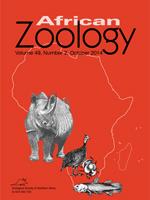The historical canalization of the Mfolozi River resulted in the St Lucia Estuary losing its main fresh-water source. This, combined with the recent drought, led to low water levels, hypersaline conditions and dramatic losses in biodiversity. The excavation of a beach spillway between the estuary and the Mfolozi River mouth in 2012, combined with the commencement of a wet phase in the preceding year, has alleviated the freshwater deprivation crisis. This study compares the meso-zooplankton composition within the channel on both flood and ebb tides, providing a preliminary understanding of the role of the Mfolozi channel in the migration and recruitment of organisms. Abundance was higher on ebb tides, while species richness was higher on flood tides. A total of 53 zooplankton taxa were recorded in the channel. Of these, one had never been recorded in St Lucia before, namely the gastropod Pterotrachea cf. hippocampus. Additionally, the ctenophore Pleurobrachia cf. pileus and the mysid Gastrosaccus gordonae were again recorded for the first time since the late 1970s. Results show that the beach spillway has facilitated recruitment into St Lucia from the ocean and the Mfolozi River. Further research is needed to ascertain what effect this recruitment has on long-term zooplankton community structure.
How to translate text using browser tools
1 October 2014
Meso-Zooplankton Movement through the Newly Constructed Mfolozi Channel into and out of the St Lucia Estuary, South Africa
Sean van Elden,
Michael J. Dyer,
Nicola K. Carrasco,
Renzo Perissinotto
ACCESS THE FULL ARTICLE

African Zoology
Vol. 49 • No. 2
October 2014
Vol. 49 • No. 2
October 2014
ebb and flood tides
iSimangaliso Wetland Park
Mfolozi channel
relinkage
zooplankton community structure




